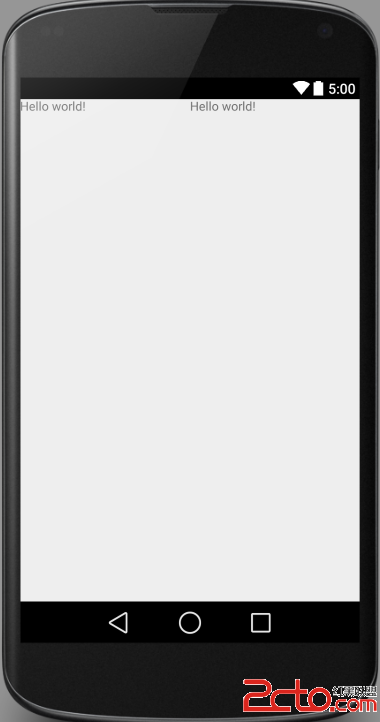編輯:關於Android編程
Android對於藍牙開發從2.0版本的sdk才開始支持,而且模擬器不支持,測試至少需要兩部手機,所以制約了很多技術人員的開發。
1. 首先,要操作藍牙,先要在AndroidManifest.xml裡加入權限
// 管理藍牙設備的權限
<uses-permissionandroid:name="android.permission.BLUETOOTH_ADMIN" />
// 使用藍牙設備的權限
<uses-permissionandroid:name="android.permission.BLUETOOTH" />
2.打開藍牙
獲得藍牙適配器(android.bluetooth.BluetoothAdapter),檢查該設備是否支持藍牙,如果支持,就打開藍牙。
[java]
// 檢查設備是否支持藍牙
adapter = BluetoothAdapter.getDefaultAdapter();
if (adapter == null)
{
// 設備不支持藍牙
}
// 打開藍牙
if (!adapter.isEnabled())
{
Intent intent = new Intent(BluetoothAdapter.ACTION_REQUEST_ENABLE);
// 設置藍牙可見性,最多300秒
intent.putExtra(BluetoothAdapter.EXTRA_DISCOVERABLE_DURATION, 300);
context.startActivity(intent);
}
// 檢查設備是否支持藍牙
adapter = BluetoothAdapter.getDefaultAdapter();
if (adapter == null)
{
// 設備不支持藍牙
}
// 打開藍牙
if (!adapter.isEnabled())
{
Intent intent = new Intent(BluetoothAdapter.ACTION_REQUEST_ENABLE);
// 設置藍牙可見性,最多300秒
intent.putExtra(BluetoothAdapter.EXTRA_DISCOVERABLE_DURATION, 300);
context.startActivity(intent);
}
3.獲取已配對的藍牙設備(android.bluetooth.BluetoothDevice)
首次連接某藍牙設備需要先配對,一旦配對成功,該設備的信息會被保存,以後連接時無需再配對,所以已配對的設備不一定是能連接的。
[java]
BluetoothAdapter adapter = BluetoothAdapter.getDefaultAdapter();
Set<BluetoothDevice> devices = adapter.getBondedDevices();
for(int i=0; i<devices.size(); i++)
{
BluetoothDevice device = (BluetoothDevice) devices.iterator().next();
System.out.println(device.getName());
}
BluetoothAdapter adapter = BluetoothAdapter.getDefaultAdapter();
Set<BluetoothDevice> devices = adapter.getBondedDevices();
for(int i=0; i<devices.size(); i++)
{
BluetoothDevice device = (BluetoothDevice) devices.iterator().next();
System.out.println(device.getName());
}
4.搜索周圍的藍牙設備
適配器搜索藍牙設備後將結果以廣播形式傳出去,所以需要自定義一個繼承廣播的類,在onReceive方法中獲得並處理藍牙設備的搜索結果。
[java]
// 設置廣播信息過濾
IntentFilter intentFilter = new IntentFilter();
intentFilter.addAction(BluetoothDevice.ACTION_FOUND);
intentFilter.addAction(BluetoothDevice.ACTION_BOND_STATE_CHANGED);
intentFilter.addAction(BluetoothAdapter.ACTION_SCAN_MODE_CHANGED);
intentFilter.addAction(BluetoothAdapter.ACTION_STATE_CHANGED);
// 注冊廣播接收器,接收並處理搜索結果
context.registerReceiver(receiver, intentFilter);
// 尋找藍牙設備,android會將查找到的設備以廣播形式發出去
adapter.startDiscovery();
// 設置廣播信息過濾
IntentFilter intentFilter = new IntentFilter();
intentFilter.addAction(BluetoothDevice.ACTION_FOUND);
intentFilter.addAction(BluetoothDevice.ACTION_BOND_STATE_CHANGED);
intentFilter.addAction(BluetoothAdapter.ACTION_SCAN_MODE_CHANGED);
intentFilter.addAction(BluetoothAdapter.ACTION_STATE_CHANGED);
// 注冊廣播接收器,接收並處理搜索結果
context.registerReceiver(receiver, intentFilter);
// 尋找藍牙設備,android會將查找到的設備以廣播形式發出去
adapter.startDiscovery(); 自定義廣播類
[java]
private BroadcastReceiver receiver = new BroadcastReceiver() {
@Override
public void onReceive(Context context, Intent intent) {
String action = intent.getAction();
if (BluetoothDevice.ACTION_FOUND.equals(action)) {
BluetoothDevice device = intent.getParcelableExtra(BluetoothDevice.EXTRA_DEVICE);
System.out.println(device.getName());
}
}
}
private BroadcastReceiver receiver = new BroadcastReceiver() {
@Override
public void onReceive(Context context, Intent intent) {
String action = intent.getAction();
if (BluetoothDevice.ACTION_FOUND.equals(action)) {
BluetoothDevice device = intent.getParcelableExtra(BluetoothDevice.EXTRA_DEVICE);
System.out.println(device.getName());
}
}
}
5.藍牙設備的配對和狀態監視
[java]
private BroadcastReceiver receiver = new BroadcastReceiver() {
@Override
public void onReceive(Context context, Intent intent) {
String action = intent.getAction();
if (BluetoothDevice.ACTION_FOUND.equals(action)) {
// 獲取查找到的藍牙設備
BluetoothDevice device = intent.getParcelableExtra(BluetoothDevice.EXTRA_DEVICE);
System.out.println(device.getName());
// 如果查找到的設備符合要連接的設備,處理
if (device.getName().equalsIgnoreCase(name)) {
// 搜索藍牙設備的過程占用資源比較多,一旦找到需要連接的設備後需要及時關閉搜索
adapter.cancelDiscovery();
// 獲取藍牙設備的連接狀態
connectState = device.getBondState();
switch (connectState) {
// 未配對
case BluetoothDevice.BOND_NONE:
// 配對
try {
Method createBondMethod = BluetoothDevice.class.getMethod("createBond");
createBondMethod.invoke(device);
} catch (Exception e) {
e.printStackTrace();
}
break;
// 已配對
case BluetoothDevice.BOND_BONDED:
try {
// 連接
connect(device);
} catch (IOException e) {
e.printStackTrace();
}
break;
}
}
} else if(BluetoothDevice.ACTION_BOND_STATE_CHANGED.equals(action)) {
// 狀態改變的廣播
BluetoothDevice device = intent.getParcelableExtra(BluetoothDevice.EXTRA_DEVICE);
if (device.getName().equalsIgnoreCase(name)) {
connectState = device.getBondState();
switch (connectState) {
case BluetoothDevice.BOND_NONE:
break;
case BluetoothDevice.BOND_BONDING:
break;
case BluetoothDevice.BOND_BONDED:
try {
// 連接
connect(device);
} catch (IOException e) {
e.printStackTrace();
}
break;
}
}
}
}
}
private BroadcastReceiver receiver = new BroadcastReceiver() {
@Override
public void onReceive(Context context, Intent intent) {
String action = intent.getAction();
if (BluetoothDevice.ACTION_FOUND.equals(action)) {
// 獲取查找到的藍牙設備
BluetoothDevice device = intent.getParcelableExtra(BluetoothDevice.EXTRA_DEVICE);
System.out.println(device.getName());
// 如果查找到的設備符合要連接的設備,處理
if (device.getName().equalsIgnoreCase(name)) {
// 搜索藍牙設備的過程占用資源比較多,一旦找到需要連接的設備後需要及時關閉搜索
adapter.cancelDiscovery();
// 獲取藍牙設備的連接狀態
connectState = device.getBondState();
switch (connectState) {
// 未配對
case BluetoothDevice.BOND_NONE:
// 配對
try {
Method createBondMethod = BluetoothDevice.class.getMethod("createBond");
createBondMethod.invoke(device);
} catch (Exception e) {
e.printStackTrace();
}
break;
// 已配對
case BluetoothDevice.BOND_BONDED:
try {
// 連接
connect(device);
} catch (IOException e) {
e.printStackTrace();
}
break;
}
}
} else if(BluetoothDevice.ACTION_BOND_STATE_CHANGED.equals(action)) {
// 狀態改變的廣播
BluetoothDevice device = intent.getParcelableExtra(BluetoothDevice.EXTRA_DEVICE);
if (device.getName().equalsIgnoreCase(name)) {
connectState = device.getBondState();
switch (connectState) {
case BluetoothDevice.BOND_NONE:
break;
case BluetoothDevice.BOND_BONDING:
break;
case BluetoothDevice.BOND_BONDED:
try {
// 連接
connect(device);
} catch (IOException e) {
e.printStackTrace();
}
break;
}
}
}
}
} 6.藍牙設備的連接
[java]
private void connect(BluetoothDevice device) throws IOException {
// 固定的UUID
final String SPP_UUID = "00001101-0000-1000-8000-00805F9B34FB";
UUID uuid = UUID.fromString(SPP_UUID);
BluetoothSocket socket = device.createRfcommSocketToServiceRecord(uuid);
socket.connect();
}
private void connect(BluetoothDevice device) throws IOException {
// 固定的UUID
final String SPP_UUID = "00001101-0000-1000-8000-00805F9B34FB";
UUID uuid = UUID.fromString(SPP_UUID);
BluetoothSocket socket = device.createRfcommSocketToServiceRecord(uuid);
socket.connect();
}
本篇文章來源於 Linux公社網站(www.linuxidc.com) 原文鏈接:http://www.linuxidc.com/Linux/2011-12/48374.htm
1.BluetoothAdapter 顧名思義,藍牙適配器,直到我們建立bluetoothSocket連接之前,都要不斷操作它
BluetoothAdapter裡的方法很多,常用的有以下幾個:
cancelDiscovery() 根據字面意思,是取消發現,也就是說當我們正在搜索設備的時候調用這個方法將不再繼續搜索
disable()關閉藍牙
enable()打開藍牙,這個方法打開藍牙不會彈出提示,更多的時候我們需要問下用戶是否打開,一下這兩行代碼同樣是打開藍牙,不過會提示用戶:
Intemtenabler=new Intent(BluetoothAdapter.ACTION_REQUEST_ENABLE);
startActivityForResult(enabler,reCode);//同startActivity(enabler);
getAddress()獲取本地藍牙地址
getDefaultAdapter()獲取默認BluetoothAdapter,實際上,也只有這一種方法獲取BluetoothAdapter
getName()獲取本地藍牙名稱
getRemoteDevice(String address)根據藍牙地址獲取遠程藍牙設備
getState()獲取本地藍牙適配器當前狀態(感覺可能調試的時候更需要)
isDiscovering()判斷當前是否正在查找設備,是返回true
isEnabled()判斷藍牙是否打開,已打開返回true,否則,返回false
listenUsingRfcommWithServiceRecord(String name,UUID uuid)根據名稱,UUID創建並返回BluetoothServerSocket,這是創建BluetoothSocket服務器端的第一步
startDiscovery()開始搜索,這是搜索的第一步
2.BluetoothDevice看名字就知道,這個類描述了一個藍牙設備
createRfcommSocketToServiceRecord(UUIDuuid)根據UUID創建並返回一個BluetoothSocket
這個方法也是我們獲取BluetoothDevice的目的——創建BluetoothSocket
這個類其他的方法,如getAddress(),getName(),同BluetoothAdapter
3.BluetoothServerSocket如果去除了Bluetooth相信大家一定再熟悉不過了,既然是Socket,方法就應該都差不多,
這個類一種只有三個方法
兩個重載的accept(),accept(inttimeout)兩者的區別在於後面的方法指定了過時時間,需要注意的是,執行這兩個方法的時候,直到接收到了客戶端的請求(或是過期之後),都會阻塞線程,應該放在新線程裡運行!
還有一點需要注意的是,這兩個方法都返回一個BluetoothSocket,最後的連接也是服務器端與客戶端的兩個BluetoothSocket的連接
close()這個就不用說了吧,翻譯一下——關閉!
4.BluetoothSocket,跟BluetoothServerSocket相對,是客戶端
一共5個方法,不出意外,都會用到
close(),關閉
connect()連接
getInptuStream()獲取輸入流
getOutputStream()獲取輸出流
getRemoteDevice()獲取遠程設備,這裡指的是獲取bluetoothSocket指定連接的那個遠程藍牙設備
 Android優化——UI優化(一)
Android優化——UI優化(一)
優化布局層次1.避免布局鑲嵌過深(如下) 我們完全可以去掉id為:main_ll_
 自定義View來顯示多條支付信息
自定義View來顯示多條支付信息
在做項目開發時,有個這樣的需求:就中間的那個支付明細,要求點擊時能收縮,這個功能非常簡單,從界面來看,用LinearLayout或TableLayout來做,沒啥難度,但
 從零開始學android小示例程序
從零開始學android小示例程序
布局文件復制代碼 代碼如下:<RelativeLayout xmlns:android=http://schemas.android.com/apk/res/and
 Android中Activity之間跳轉和參數傳遞的實例
Android中Activity之間跳轉和參數傳遞的實例
一個activity就好比一個網頁,此文章講解怎樣創建一個activity並且實現跳轉!一、學習創建Activity1、新建一個java類,右擊src目錄,選擇new--